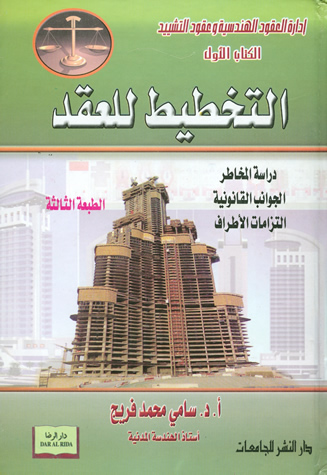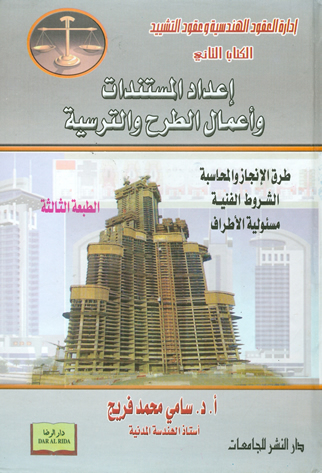Books
This series of five books presents comprehensive coverage of contract management for contract managers to enable them to fulfil their role during the life cycle of the project. These works are being widely used by professional engineers in the construction industry in the Middle East, and as reference texts by undergraduate and graduate engineering students throughout the Middle East and North Africa. A compendium of these five books is planned for use as a reference text by engineering students at academic institutions in the Middle East, and an English translation of each book is expected to be available in 2017.
Book 1: Contract Planning: Risk Management, Legal Aspects and Parties' Obligations
3rd Edition. 656 pp. ISBN #977-5365-85-6
 Book One addresses contract planning and risk management of the project, presenting an understanding of risk management and the law, where the parties’ obligations are explained to enable the contract manager to design the contract to fulfil the contract’s objectives. Ethical aspects of the profession are also addressed. Each party has obligations and rights which can be interfering and intertwined. Thus it is important that planning takes place to ensure that every party understands its role to successfully achieve the project’s objectives. These include preparing the contract manager to fulfil his role as a designer of the contract and preparer of the necessary contract documents. Next, the construction manager can fulfil his role by ensuring that he is capable of resolving disputes which might arise during construction within the contractual and legal framework outlined in the contract. The book contains ten chapters. Chapter 1 deals with managing contracts and the life cycle of the project and the contracts. Chapter 2 explains the different risks which might arise during the project’s different phases and how to manage such risks. Chapter 3 deals with the legal aspects of the engineering contracts. Chapter 4 addresses professional ethics with reference to the local Islamic perspective. Chapter 5 explains how the rights have been established and their different divisions according to the applicable civil codes. Chapter 6 deals with the most common obligations of each party in a construction contract, while Chapter 7 addresses construction contracts under the Civil Law. Chapter 8 deals with contract execution, while Chapter 9 describes contract obligations, and Chapter 10 explains contract close-out.
Book One addresses contract planning and risk management of the project, presenting an understanding of risk management and the law, where the parties’ obligations are explained to enable the contract manager to design the contract to fulfil the contract’s objectives. Ethical aspects of the profession are also addressed. Each party has obligations and rights which can be interfering and intertwined. Thus it is important that planning takes place to ensure that every party understands its role to successfully achieve the project’s objectives. These include preparing the contract manager to fulfil his role as a designer of the contract and preparer of the necessary contract documents. Next, the construction manager can fulfil his role by ensuring that he is capable of resolving disputes which might arise during construction within the contractual and legal framework outlined in the contract. The book contains ten chapters. Chapter 1 deals with managing contracts and the life cycle of the project and the contracts. Chapter 2 explains the different risks which might arise during the project’s different phases and how to manage such risks. Chapter 3 deals with the legal aspects of the engineering contracts. Chapter 4 addresses professional ethics with reference to the local Islamic perspective. Chapter 5 explains how the rights have been established and their different divisions according to the applicable civil codes. Chapter 6 deals with the most common obligations of each party in a construction contract, while Chapter 7 addresses construction contracts under the Civil Law. Chapter 8 deals with contract execution, while Chapter 9 describes contract obligations, and Chapter 10 explains contract close-out.
Book 2: Document Preparation, Tendering and Bidding: Project Delivery Systems,
Payment Methods and Specification-Writing
3rd Edition. 376 pp. ISBN # 977-316-206-0
 Book Two deals with selecting the most effective project delivery system and preparing the contract documents. It also covers how to administer the process of tendering, bidding and award to select the most competent contractor to ensure the project’s successful completion and avoid disputes. These documents are used to carry out the work and they detail the obligations and roles of the parties and the proposed project delivery system. Following the process of preparing is the tendering procedure, followed by bidding and studying the bids to select the most suitable contractor and then awarding the contract to that contractor. The book is divided into seven chapters. Chapter 1 outlines the project life cycle and definitions, while Chapter 2 explains the different project delivery systems. Chapter 3 presents preparation of technical specifications, instructions to bidders and all the necessary bidding documents. Chapter 4 deals with insurance and bonding needed to safeguard the interests of the parties in the project. Chapter 5 outlines the responsibilities of the parties regarding correctness of such documents. Chapter 6 deals with tendering the project, studying bids, awarding, and qualifying contractors. Finally, Chapter 7 focuses on managing the whole stage and monitoring every phase to ensure that the documents are of high quality to avoid any future problems. Each chapter includes different case studies to explain the underlying ideas, using real-life cases.
Book Two deals with selecting the most effective project delivery system and preparing the contract documents. It also covers how to administer the process of tendering, bidding and award to select the most competent contractor to ensure the project’s successful completion and avoid disputes. These documents are used to carry out the work and they detail the obligations and roles of the parties and the proposed project delivery system. Following the process of preparing is the tendering procedure, followed by bidding and studying the bids to select the most suitable contractor and then awarding the contract to that contractor. The book is divided into seven chapters. Chapter 1 outlines the project life cycle and definitions, while Chapter 2 explains the different project delivery systems. Chapter 3 presents preparation of technical specifications, instructions to bidders and all the necessary bidding documents. Chapter 4 deals with insurance and bonding needed to safeguard the interests of the parties in the project. Chapter 5 outlines the responsibilities of the parties regarding correctness of such documents. Chapter 6 deals with tendering the project, studying bids, awarding, and qualifying contractors. Finally, Chapter 7 focuses on managing the whole stage and monitoring every phase to ensure that the documents are of high quality to avoid any future problems. Each chapter includes different case studies to explain the underlying ideas, using real-life cases.
Book 3: Financial and Time Program for Projects: Preparation and Control
3rd Edition. 352 pp. ISBN # 977-316-213-3
 Book Three addresses the financial and time program of the work, preparing project schedules, budgets and cost estimates, and how to manage and control the cost and time of the project to avoid any delays and cost overruns. Two important components of any project are time and cost, which are important criteria for defining the project’s success by completing the project within the given time and cost frames. This makes the planning process of monitoring and control for these two components of utmost importance. The book contains sixteen chapters. Chapter 1 addresses the planning techniques of the project and their advantages and disadvantages, while Chapter 2 explains how to build a project network. Chapter 3 deals with the time analysis of the project and calculation of the critical path using the network technique. Chapter 4 presents resource management, leveling and allocation. Chapter 5 explains scheduling of repetivite units. Chapter 6 deals with program presentation. Chapter 7 addresses cost estimation for the project in general. Chapter 8 focuses on preliminary estimates, techniques and objectives. Chapter 9 explains cost indices and how to establish them. Chapter 10 deals with parametric studies to select the most approritate elements. Chapter 11 explains how to perform a detailed cost estimate and study the indirect and direct costs associated with the project. Chapter 12 addresses the different techniques for time compression, while Chapter 13 deals with cash flow and its impact on the project’s progress. Chapter 14 explains the process of monitoring and control using earned value concepts. Chapter 15 addresses computer processing of the data. Finally, Chapter 16 presents a case study for a bridge.
Book Three addresses the financial and time program of the work, preparing project schedules, budgets and cost estimates, and how to manage and control the cost and time of the project to avoid any delays and cost overruns. Two important components of any project are time and cost, which are important criteria for defining the project’s success by completing the project within the given time and cost frames. This makes the planning process of monitoring and control for these two components of utmost importance. The book contains sixteen chapters. Chapter 1 addresses the planning techniques of the project and their advantages and disadvantages, while Chapter 2 explains how to build a project network. Chapter 3 deals with the time analysis of the project and calculation of the critical path using the network technique. Chapter 4 presents resource management, leveling and allocation. Chapter 5 explains scheduling of repetivite units. Chapter 6 deals with program presentation. Chapter 7 addresses cost estimation for the project in general. Chapter 8 focuses on preliminary estimates, techniques and objectives. Chapter 9 explains cost indices and how to establish them. Chapter 10 deals with parametric studies to select the most approritate elements. Chapter 11 explains how to perform a detailed cost estimate and study the indirect and direct costs associated with the project. Chapter 12 addresses the different techniques for time compression, while Chapter 13 deals with cash flow and its impact on the project’s progress. Chapter 14 explains the process of monitoring and control using earned value concepts. Chapter 15 addresses computer processing of the data. Finally, Chapter 16 presents a case study for a bridge.
Book 4: Contract Administration and Site Management
3rd Edition. 352 pp. ISBN #977-316-207-9
 Book Four deals with site management and contract administration, very vital processes to ensure the success of the project. This phase starts with handing over the site to the contractor and execution of the work and ends with project handover and contract close-out. The book contains ten chapters. Chapter 1 describes the roles of the parties in the construction process. Chapter 2 deals with pre-construction activities. Chapter 3 addresses project documentation, while Chapter 4 focuses on variations and work orders issued by the Employer. Chapter 5 deals with managing variations. Chapter 6 addresses contract interpretation and dispute management, while Chapter 7 discusses the causes of claims and how to prevent them. Chapter 8 deals with contractual aspects of the project and the role of the engineer in the contract execution. Chapter 9 focuses on project control, while Chapter 10 describes project handover and contract close-out.
Book Four deals with site management and contract administration, very vital processes to ensure the success of the project. This phase starts with handing over the site to the contractor and execution of the work and ends with project handover and contract close-out. The book contains ten chapters. Chapter 1 describes the roles of the parties in the construction process. Chapter 2 deals with pre-construction activities. Chapter 3 addresses project documentation, while Chapter 4 focuses on variations and work orders issued by the Employer. Chapter 5 deals with managing variations. Chapter 6 addresses contract interpretation and dispute management, while Chapter 7 discusses the causes of claims and how to prevent them. Chapter 8 deals with contractual aspects of the project and the role of the engineer in the contract execution. Chapter 9 focuses on project control, while Chapter 10 describes project handover and contract close-out.
Book 5: Dispute Resolution in Construction Projects: Amicable Solutions, Arbitration,
Damage Assessment and Parties' Entitlements
2nd Edition. 536 pp. ISBN #977-316-247-8
 Book Five discusses dispute management and dispute resolution in contracts. The focus of the first four books is on good project management to prevent disputes and avoid claims and litigation. Nevertheless, it is very common that some problems may still linger after project close-out and will need to be dealt with. This book has eleven chapters. Chapter 1 deals with human factors in conflict and dispute management, while Chapter 2 discusses negotiation and amicable solutions. Chapter 3 focuses on mediation in construction. Chapter 4 explains alternative dispute resolution in construction projects. Chapter 5 addresses arbitration, while Chapter 6 explains litigation. Chapter 7 deals with the role of experts in dispute resolution, and Chapter 8 describes torts and contractual obligations. Chapter 9 addresses delay in projects and assigning responsibilities and entitlements. Chapter 10 discusses variations and their costs, while Chapter 11 deals with amicable settlement of disputes.
Book Five discusses dispute management and dispute resolution in contracts. The focus of the first four books is on good project management to prevent disputes and avoid claims and litigation. Nevertheless, it is very common that some problems may still linger after project close-out and will need to be dealt with. This book has eleven chapters. Chapter 1 deals with human factors in conflict and dispute management, while Chapter 2 discusses negotiation and amicable solutions. Chapter 3 focuses on mediation in construction. Chapter 4 explains alternative dispute resolution in construction projects. Chapter 5 addresses arbitration, while Chapter 6 explains litigation. Chapter 7 deals with the role of experts in dispute resolution, and Chapter 8 describes torts and contractual obligations. Chapter 9 addresses delay in projects and assigning responsibilities and entitlements. Chapter 10 discusses variations and their costs, while Chapter 11 deals with amicable settlement of disputes.
